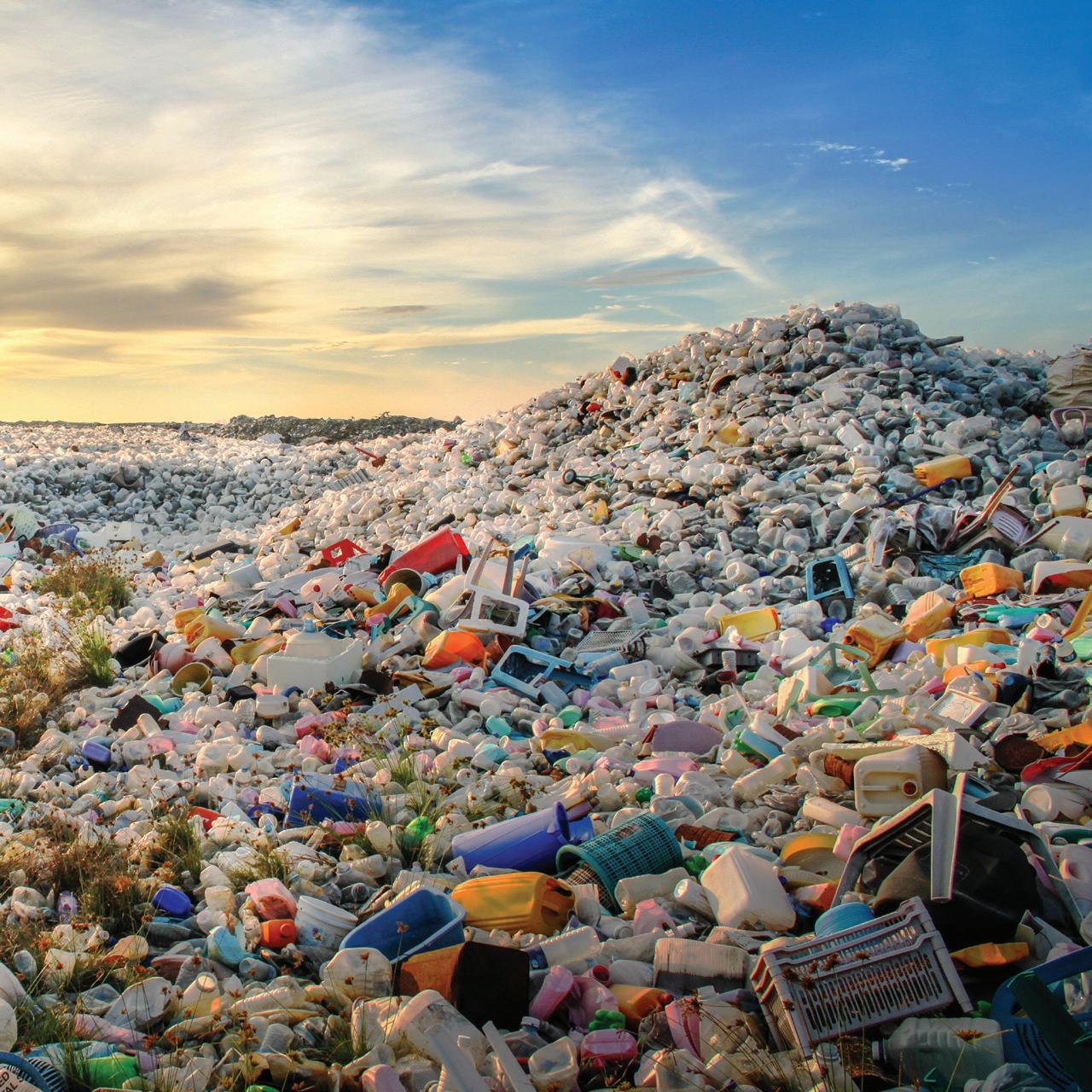STREAMING
by Christy Rupp
January 19 – April 27, 2024
Sculpture


January 19 – April 27, 2024
Sculpture
We are so pleased to present Streaming: Sculpture by Christy Rupp in the museum’s Walsh Gallery this winter, featuring more than 70 of Rupp’s artworks from across the last two decades of her career as an ecological artist and activist, as well as three new works created for this exhibition. Rupp’s artistic practice brilliantly highlights human impact on our environment through her use of plastic objects collected from the waste stream, as well as threatened species across the animal and plant worlds, as her subject matter. The exhibition will close the week of the celebration of the 54th Earth Day (April 22nd, 2024). Since calling attention to how plastics are destroying our planet is part of Earth Day’s mission, it will be an appropriate conclusion to an exhibition that we hope will prompt conversations and action among our many audiences on this topic. We hope you will join us for the array of associated programming which has been created to complement the exhibition, and which will be presented over the next few months. For information on these programs, please check the listings at the end of this brochure. Thank you to Brian Walker, PhD for serving as our faculty liaison for this exhibition as well as for the exhibition on view simultaneously in the Bellarmine Hall Galleries, Helen Glazer: Walking in Antarctica, which shares an environmental theme. All of our programs this spring are in person, but we will also continue to livestream them via thequicklive.com whenever possible. Virtual programs will also be recorded, so if you cannot join us for an event, you can look for the program on our YouTube channel a few days later.
We are very grateful to Christy Rupp for her collaboration on planning and installing this exhibition and for lending many of the works – none of this would have been possible without her enthusiastic support of this project. We would like to thank Jen Dragon for her thoughtful appraisal of Rupp’s career and works in the catalogue essay which follows.
Thanks as always go to the exceptional museum team for their hard work in bringing this exhibition and its associated programming to life: Michelle DiMarzo, Curator of Education and Academic Engagement and Megan Paqua, Museum Registrar. We are grateful for the additional support provided across the University by Edmund Ross, Susan Cipollaro, Dan Vasconez, and Tess Brown Long, as well as by our colleagues in the Quick Center for the Arts and the Media Center.
Carey Mack Weber Frank and Clara Meditz Executive DirectorSince the ‘70s, Christy Rupp’s sculptures and works on paper have explored the relationship between economics and the environment. Rupp seeks to make this complex topic – one usually examined in abstract articles – into a clear and direct visual narrative accessible beyond the language of dissertations, punditry, and scientific studies. Emerging from the lens of Discard Studies, a discipline that considers the systems and consequences of waste, Rupp weighs these systems and their short-term benefits against the long-term costs of climate degradation and the marginalization of threatened species.
Buried in history, politics, and culture, the politics of waste are rooted in consumerism with its voracious consumption and energy needs. With welded steel, foraged plastic detritus, historic, scientific, and contemporary imagery, a dark sense of humor, and the uncanny ability to connect the dots, Christy Rupp dives into this dystopia. Her artwork charts a course through the turmoil, observing the trail of collateral damage as it moves through our world, seeking to interpret and magnify these interdependencies.
Some examples of Rupp’s visual unification of cause and effect are found in her installation Moby Debris, a collection of microplanktonic organisms made from welded steel rods and discarded plastic. To quote artist and art scholar Ellen K. Levy, “Rupp considers how waste and toxic elements in our environment corrupt the accepted way in which organisms function and evolve… Each of her aquatic-inspired “organisms” is composed of discarded plastic detritus and visually comments on the damage done to species when they consume the glut of inorganic detritus hurled into our food chain.”1 In magnifying the petroplanktonic microbes that inevitably find their way into a whale’s stomach, Rupp clarifies the irony of a food chain where the smallest organisms sustain the largest mammals along with the floating oceanic plastic waste that accompanies them into a whale’s stomach. A similar statement is made with the plastic-stuffed wall works of Aquatic Larvae, with the paradox of young hatchling fishes nurtured in egg sacks populated by a buffet of accumulated microplastics.
In works such as her Pangolins and the series Remaining Balance Insufficient featuring aquatic mammal skeletons, Rupp bends and welds steel rods into graceful lines as effortlessly as if drawn on paper. The animals’ forms are then sheathed in innumerable, shimmering credit cards as they float jewel-like in the air. However, these pangolins and manatees are victims of environmental exploitation as they wrestle with human-caused habitat degradation. Rupp’s visualization of their plight equates the debt incurred with their survival, leveraged against the temporary advantage of human exploitation. Made as they are of credit cards, this work reminds us that, unlike the world of finance, the biosphere is not man-made, and it’s impossible to manipulate with numbers and percentages. Natural habitat is much easier to destroy than repair.
In addition to numerous sculptures, the exhibition features two giant digital prints on fabric that confront the emergency of non-renewable energy and plastic waste and their enduring damage to terrestrial systems. While these immense banners cannot ever be large enough to fully present this unfolding catastrophe, an abstract appreciation for the beauty of matter out of place is obvious.
As much as Christy Rupp’s art is about ecological emergencies, she is informative without being didactic, while her sense of playful wit and whimsical spirit convey the darkest news. However, her direct and accessible message does not come at the expense of aesthetics as the artist’s accomplished draftsmanship and percussive colors are at once delightful and dramatic. In visualizing the effects of ecological degradation, Christy Rupp does not pinpoint any single culprit – only because there isn’t just one cause; rather, there is a collective complacency that permeates society. Anyone who views Rupp’s work is engaged in some way as a citizen of a world in which it is easier to participate in a petrochemical-fueled lifestyle, blissfully ignorant of our burgeoning carbon footprint and impending doom.
- Jen Dragon
All works © Christy Rupp. All works are Courtesy of the Artist unless otherwise noted.
Petroplankton, 2019-2021
Collected single use plastics
1. Black Pipes 9 x 14 x 3 inches
2. Blue with Clear Circle 8 x 13 x 3 inches
3. Blue Fish 14 x 12 x 3 inches
4. Blue Mesh 11 x 13 x 3 inches
5. Brown Spots 15 x 10 x 3 inches
6. Clear Bird 8 x 11 x 3 inches
7. Clear Green 9 x 12 x 3 inches
8. Computer board 11 x 12 x 3 inches
9. Drive Case 7 x 11 x 3 inches
10. Floss Blue 9 x 13 x 3 inches
11. Green Tail 12 x 13 x 3 inches
12. Green with Pill Bottle 9 x 14 x 3 inches
Green Worm
14. Mesh Red Curler 8 x 12 x 3 inches
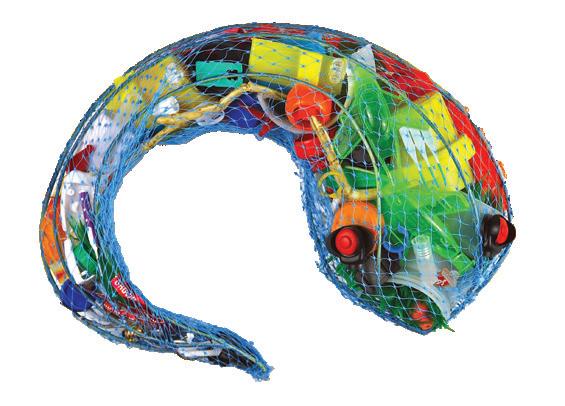
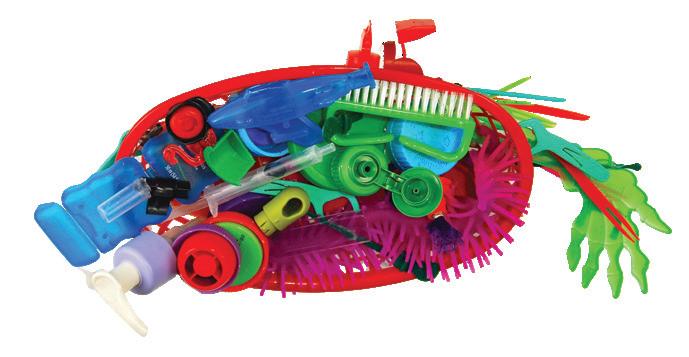
15. Orange Worm 11 x 9 x 3 inches
16. Orange Green 10 x 11 x 3 inches
17. Pill Bottles 9 x 13 x 3 inches
18. Red and Black Circuit 7 x 12 x 3 inches
19. Red Hummingbird 8 ½ x 11 x 3 inches
20. Red Fish 13 x 8 x 3 inches
21. Spray Bottle 9 x 13 x 3 inches
22. White and Black Mesh Shrimp 10 x 10 x 3 inches
23. Yellow Scrubby 9 x 10 x 2 inches
24. Yellow Lid Orange Comb 9 x 13 x 3 inches
25. Plankton 1 8 x 17 x 2 ½ inches
26. Waterbug 11 x 16 x 4 inches
27. Double Eggs 15 x 15 x 4 ½ inches
Aquatic Larvae, 2019-2020
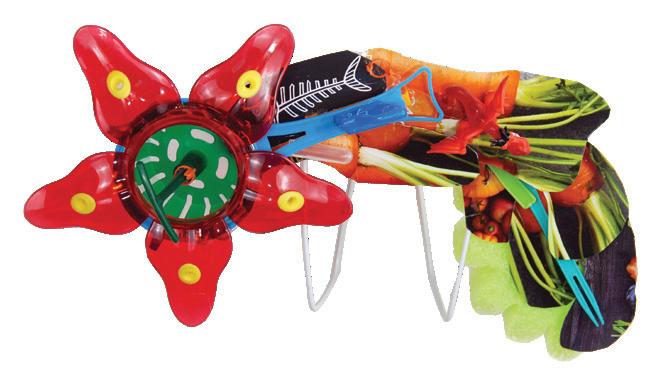
Welded steel and collected single use plastics
28. White Egg Mass 13 x 32 x 6 inches
29. Yellow Styrofoam Eggs 14 x 33 x 6 inches

30. Blue with Pill Bottles 11 x 34 x 6 inches
31. Black & White Egg Mass 14 x 32 x 6 inches
32. Red Egg Sack 15 x 34 x 6 inches
33. Clear Egg Mass with Blue and Green 15 x 30 x 6 inches
Oily Turtles, 2007-2015
34. Backhoe Turtle, 2011
Steel, paper and encaustic wax 18 x 13 x 14 inches
35. Burned Paper Turtle Shell, 2012
Steel, paper and encaustic wax 11 x 9 x 2 inches
36. Medium Oily Turtle Shell, 2011
Steel and encaustic wax 14 x 12 x 6 inches
37. Turtle Shell with Red Button, 2012
Steel and encaustic wax 13 x 13 x 5 inches
38. Wampum Turtle, 2015
Steel and encaustic wax 18 x 16 x 14 inches
39. Zero Balance Turtle, 2007
Steel and credit cards 17 x 16 x 6 inches
Moas, 2007
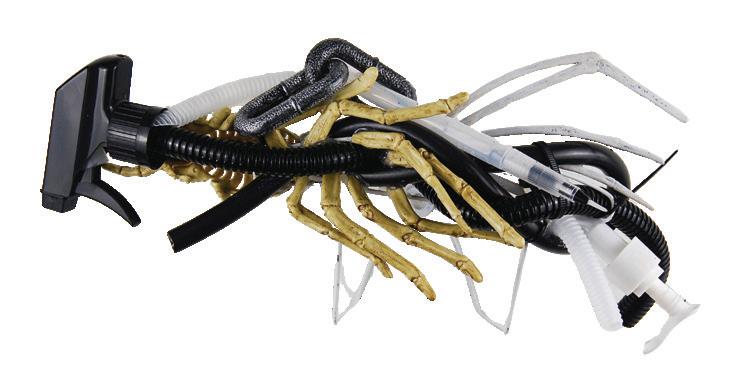
Fast food chicken bones, welded steel, paper
40. Moa 108 x 39 x 42 inches
41. Moa
58 x 58 x 26 inches

42. Quetzal, 2020
Credit cards, wood, steel, mixed media
70 x 8 x 6 ½ inches
43. Hanging Pangolin, 2022
Credit cards, steel, mixed media
38 x 17 x 18 inches
44. Walking Pangolin, 2022
Credit cards, steel, mixed media
37 x 16 x 12 inches
Lent by Dyan Machan
Fake Ivory Series, 2012
Welded steel and encaustic wax with transfers
45. Narwhal Tusk with Hydrocarbon Chains 83 x 3 ½ x 3 ½ inches
46. Elephant Tusk with Greenhouse Gasses 68 x 23 x 14 inches
Swiped Series, 2015
Steel, credit cards, mixed media
47. Frog 12 x 8 x 7 inches



55. Remaining Balance Insufficient, 2015
Welded steel, gold credit cards, and plastic gift cards
122 x 43 x 17 inches
Snagged Series, 2017
Plastic net bags, steel, plastic, fishline and paint
56. Parrots (after Frida Kahlo, ca.1937)
15 x 10 x 5 inches
57. The Goldfinch (after Carel Fabritius, 1654)
11 x 9 ½ x 6 inches
58. Bird Pin (after Louise Bourgeois, ca. 1985)
17 x 38 x 1 inches
Lent by the Collection of Joshua Rechnitz, New York
59. Threatened Swan (after Jan Asselijn)
24 x 41 x 15 inches
Lent by the Collection of Joshua Rechnitz, New York
60. Bird in Space (after Constantin Brancusi, versions 1923–1940)
66 x 7 x 7 inches
61. Bird of Death (after Hieronymus Bosch)
38 x 20 x 9 inches
Lent by Dyan Machan
62. Dove (after Pablo Picasso, 1949)
14 x 11 x 3 inches
Rainforest Sources of Bio-Pirated Western Medicines, 2014
Welded steel, paper, and wax
63. Snake (Captopril for heart failure, stroke)
27 x 18 x 5 inches
64. Blowfish (Tetrodotoxin pain suppressant, heroin substitute)
18 ½ x 12 x 7 inches
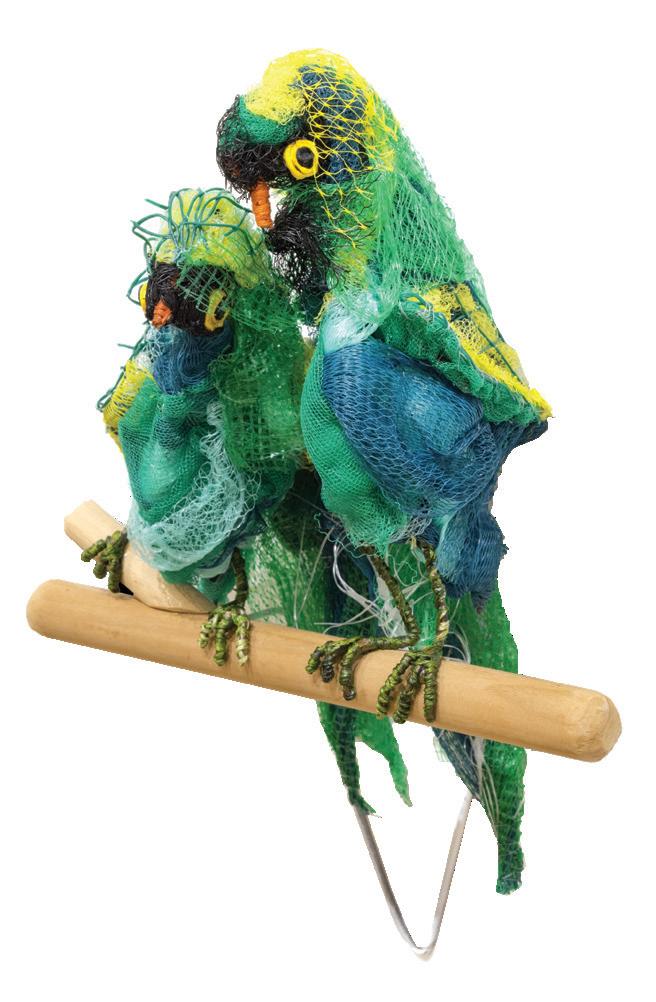
65. Curare plant (Tubocurarine, muscle relaxant, anesthetic)
16 x 12 x 3 inches
66. Fire Ant (Solenopsin antibiotic, anti-coagulant, rheumatism)
20 x 11 x 11 inches
67. Frog (Epibatidine, pain killer)
1 x 19 x 4 inches
68. Tree Fungus (Polysaccharide Peptide, lungs, colon, stomach cancers)
14 x 9 x 9 inches
69. Felted Oil Cans, 2010 Life-size hand-felted wool portraits of oil containers
Dimensions variable
70. Nesting Pesticide Dolls, 2017 Wood and paint
Dimensions variable
71. Spheres: Glass Hands, 2004 Glass
7 inches (diameter)
72. Spheres: Chicken Bones, 2007 Chicken bones
7 inches (diameter)
73. Spheres: Wasp Paper, 2012 Wasp paper
7 inches (diameter)
74. Spheres: Twigs, 2018 Twigs
7 inches (diameter)
75. Plastic Landscape, 2023 Digital print from stock photo, printed on fabric 20 x 40 feet

76. On Demand, 2022
Digital print from cut paper collage (2019), printed on fabric 10 x 38 feet
77. Lemur 1, 2023
Welded steel, toy chainsaws and collected single use plastic debris
29 x 17 x 17 inches
78. Lemur 2, 2023
Welded steel, toy chainsaws and collected single use plastic debris
26 x 15 x 16 inches

Events listed below with a location are live, in-person programs. When possible, those events will also be streamed on thequicklive.com and the recordings posted to our YouTube channel.
Register at: fuam.eventbrite.com
Thursday, January 18, 2024, 5 p.m.
Opening Night Lecture: Christy Rupp
Quick Center for the Arts, Kelley Theatre and streaming on thequicklive.com
Presented as part of the Edwin L. Wiesel Jr. Lectureships in Art History, funded by the Robert Lehman Foundation
Thursday, January 18, 2024, 6-8 p.m.
Opening Reception
Quick Center for the Arts, Lobby and Walsh Gallery
Saturday, March 23, 12:30-2 p.m. and 2:30-4 p.m.
Family Day: Re-Re-Re-Recycle!
Quick Center for the Arts, Walsh Gallery Space is limited; registration required
Thursday, April 11, 11 a.m. (in-person, Walsh Gallery) and 12 noon (thequicklive.com)
Art in Focus: Christy Rupp, The Goldfinch (after Carel Fabritius), 2017

